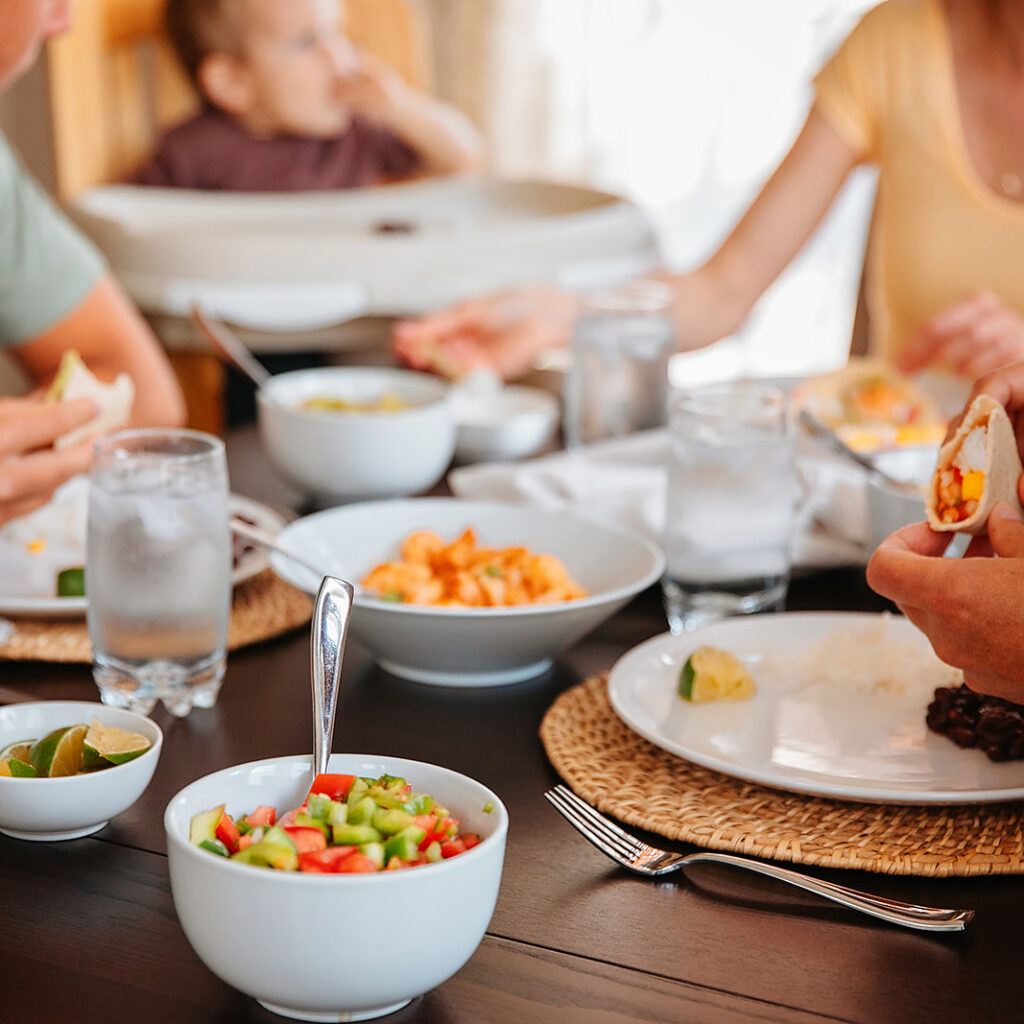Picky eating is a normal phase for kids that they can overcome with lots of low-pressure food exposures. Learn exactly what that looks like.
 It is VERY normal for kids ages 2-5 years to go through a “picky” phase. They used to eat everything! And now? They only want mac and cheese and chicken nuggets.
It is VERY normal for kids ages 2-5 years to go through a “picky” phase. They used to eat everything! And now? They only want mac and cheese and chicken nuggets.
BUT – did you know that it can take up to TWENTY exposures to a new food before the brain can truly determine if it’s a “like” or “dislike?”
One of the keys to overcoming picky eating is to try again… and again, and again!
The most important thing for you to do as the parent is to continue to offer a variety of foods in a low-pressure environment.
As a toddler mom myself, I know that’s easier said than done. Let me show you exactly how to navigate this season of life.
What Counts as a Low-Pressure Food Exposure for a Picky Eater?
I know it sounds like a lot of work to offer a food to your kiddo twenty different times – with the answer potentially being “No!” for 19 of them.
The good news is that your child doesn’t have to eat the food – or even put it in their mouth – for it to count as one of these “food exposures!”
 Here are a few examples of food exposures you can try if your child does NOT want anything to do with eating a food:
Here are a few examples of food exposures you can try if your child does NOT want anything to do with eating a food:
- Watching you eat a food
- Growing or harvesting the food
- Helping prepare the food
- Seeing the food on the table
- Noticing the smell or texture of a food
- Playing with the food
- Learning about a food
- Seeing their friends eat a food
- Putting the food in their mouth and then spitting it back out
Did you notice that actually eating the food isn’t even on that list?
Simply by seeing the food on the table and observing YOU enjoying food can help your picky eater move through this phase!
Learning this was a huge relief. It makes family mealtime easier for all of us!
What to Do if your Picky Eater Doesn’t Like the New Food
Did your child just scream, “NO!!” in your face when you offered them a new food?
Here’s what to do:
First, play it cool. While it can be very frustrating, it’s also totally normal for your picky eater to refuse a new food. It’s also normal for them to suddenly decide they don’t like a food that they used to love.
You’re not doing anything wrong and your child isn’t a terrible kid!
When this happens, respond in a calm voice with a neutral phrase that offers the possibility of them trying the food in the future.
Here are some of the phrases I use when my toddler screams “NO!” to my suggestion that he try some zucchini:
“You don’t have to eat this.”
“You can try it later if you want to.”
“I hear you don’t want any zucchini right now.”
Next, make sure to always offer a “safe food” at every meal. A “safe food” is one you know they like, which removes some of the fear around new foods because your child knows they have SOMETHING to eat.
Having a safe food at the table can actually make them MORE likely to try a new food!
In fact, I recommend to ask your picky eater several times during the meal if they’d like to try the food. Make sure you’re simply offering, without putting any pressure on your child. You might be surprised that they say “yes!” At least sometimes, anyway.

Meal Planning to Provide Food Exposures for Picky Eaters
I get asked this question a lot: “What should I feed my picky eater?”
You don’t have to be a short-order cook and make multiple meals every night. Nor do you have to send your child to bed hungry because they didn’t like what you serve.
Instead, follow this plan to help expose your child to new foods AND make sure they have something to fill their tummies:
 Step 1: Plan your menu around what YOU like. If you make a meal and nobody else likes it, you can still enjoy what you’re eating, without feeling offended that others aren’t eating.
Step 1: Plan your menu around what YOU like. If you make a meal and nobody else likes it, you can still enjoy what you’re eating, without feeling offended that others aren’t eating.
Step 2: Offer a “safe food” for your picky eaters. A “safe food” is one you know they like, which removes some of the fear around new foods because your child knows they have SOMETHING to eat.
Step 3: Move on! Your job is to provide WHAT, WHEN, and WHERE to eat. Your child’s job is to decide IF and HOW MUCH to eat (read more about the Division of Responsibility). If you’ve provided a safe food and your child decides not to eat, that’s okay!
Remember – it’s normal for it to take up to 20 (TWENTY!) exposures to a new food before your child will like it. Instead of stressing about this, simply plan for it!
Your child is allowed to decide not to eat dinner; you don’t have to cook another meal for them.
Simply make sure to offer another “safe food” at a meal or snack within 2-3 hours so they can have an opportunity to eat if they’re hungry.
Which Foods to Serve your Picky Eater
When you have picky eaters, it’s easy to start planning meals around what you *think* they will eat.
 Unfortunately, this can cause some problems in the long run.
Unfortunately, this can cause some problems in the long run.
Kids don’t magically grow out of their picky phase. They must be exposed to many different textures, flavors, and foods to become adventurous eaters.
If you only ever serve mac & cheese and chicken nuggets, that’s all they’ll ever learn to like!
Instead, you focus on providing variety at the dinner table. Include different kinds of vegetables, choose unique seasonings, or try other cuisines.
If this question stresses you out, the Peas and Hoppy Meal Guides app can help!
Our registered dietitian (me!) plans the menu each week to give you tons of variety without the overwhelm of searching through cookbooks or scrolling Pinterest.
Click here to try it out free for a week. Plans start at just $14.99/month!
Which Foods to Avoid Serving your Picky Eater
As a Certified Intuitive Eating Counselor, I know all foods are morally equivalent and can fit into a healthy eating pattern.
As a Registered Dietitian, I understand that not all foods are nutritionally equal.
Ultra-processed foods have been called out for lacking many nutrients that children (and adults!) need. Foods like boxed mac & cheese, chips, and sweetened cereals often don’t contain enough fiber, vitamins, minerals, or phytochemicals that our bodies need.
These foods are also engineered to what’s called the “bliss point” of flavor. The “bliss point” is the perfect combination of sugar, salt, and fat which makes your taste buds sing!
If you eat a lot of these foods, whole foods as they’re found in nature will taste very bland in comparison.
BUT – and this is very important – restricting these foods often backfires later. It can lead to disordered eating patterns such as sneaking food or out-of-control eating.

Instead, focus on including whole foods. Choose fruits and whole grain crackers for snacks. Include roasted vegetables and whole proteins like chicken or black beans for meals.
I know this is easier said than done, so to get started:
First – Make sure you’re planning meals and snacks ahead of time. This meal planning template will help!
Second – Use a meal planning app like the Peas and Hoppy Meal Guides. As a registered dietitian and mom myself, I plan the menus each week to include delicious flavors using whole food ingredients that are easy to find.
Please note that many ultra-processed foods are more affordable than buying fresh. If it’s a choice between going hungry or eating an ultra-processed food, mac & cheese wins every time! I understand this is unfortunately a privileged conversation about food. There is no shame in feeding your family.
Create a Happy Environment at the Dinner Table
A peaceful dinner table can transform mealtime into a joyful occasion rather than just another chore.
You’ll find it easier to give your picky eaters the positive, low-pressure food exposures they need to become adventurous eaters.

To make this journey easier, consider using our meal planning app.
With a meal plan that’s made for you every week by our registered dietitian, you’ll spend so much less time worrying about what to make for dinner.
Your weekly meal plan is fully customizable, so you can substitute recipes from over 800 options in the app to cater to everyone’s taste.
Download the app today and start creating joyful meals together!
Most importantly, remember you’re doing great.
It feels hard because it IS hard. But you can do hard things! You got this.
Happy family mealtime,
Dietitian Ann
Mealtime Variety Made Easy
Stuck in a rut at dinnertime? Beat the boredom with 10 fresh meal ideas every week with the Peas and Hoppy Meal Guides app!
Each weekly menu includes ideas for breakfast, lunch, dinner, and snacks. Download the app for free to get started.
Create Free Account
Learn More
“My family has loved everything I’ve tried with the Peas and Hoppy Meal Guides and recipes. I’m so happy know that whatever I’m choosing is going to be healthy, good food for my family.”
-Kathy Colaiacovo, premium subscriber of the Peas & Hoppy Meal Guides
Meal Planning, Simplified
Save yourself time, money, and stress this week by making a meal plan that WORKS for your busy schedule! Learn our easy 3-step process when you download this meal planning template. Enjoy family mealtime this week!


